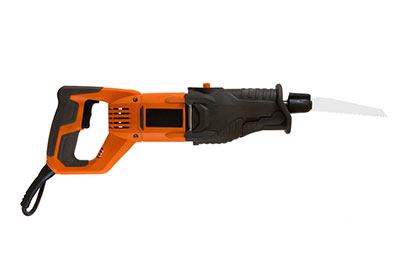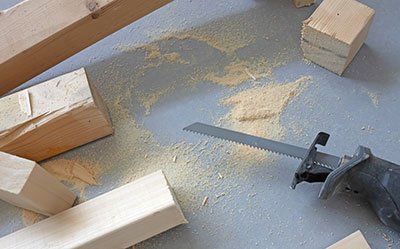If you've used a power tool before, you've surely crossed paths with a reciprocating saw or a jigsaw. They are the best in the business for cutting wood, but they operate a bit differently, despite belonging to the same family of saws.
Both devices operate using the same method, push-and-pull, which offers the user extreme control while making straight and curved cuts, but they have a lot of differences in terms of build and internal composition.
Now, you might wonder, reciprocating saw vs. jigsaw: which one's better? It's a normal question given the high demand for both devices, so this article is pointed toward explaining to you their similarities and differences in order to derive some sort of solution to the question.
We'll go in-depth and try to make it as simple as possible. While we do that, your job is to get some coffee and relax while reading this article. Have we got a deal? Let's dig in!
More...
General Information: The Overviews
Before we start comparing and finding the answer to our aforementioned question, we thought it would be nice to offer you some general information about these devices and show you in a couple of lines how they work. So, here it is!
1. Reciprocating saws
Reciprocating saws are essentially power saws that work utilizing the backward and forward motion of a recip saw blade. The blade moves at large speeds to give your stock a straight cut with a clean and finessed depth.
These types of saws can be classified into two categories: wood and metal reciprocating saws. Based on the true type of material you're cutting, you'll choose the correlating blades and move on from there. Generally, the saws for metal are corded since they provide a lot more power, but you'll see a cordless reciprocating saw here and there that can match the energy output of a corded unit.
Speaking of power sources, you should also know that cordless reciprocating saws are a woodworker's savior. They are quite lightweight, easy to use, and their batteries will usually give you at least an hour of running time. Therefore, we have another classification: cordless and corded reciprocating saws.
On top of this, you can also find specialized units that have abrasive blades or strips that are designed to cut irregular material, such as cement or blocks. These blades don't have teeth, so their cut is a bit rough, to say the least.

2. Jigsaws
On the other side of the cutting spectrum, we have jigsaws: strong power saws that operate at the same principles as reciprocating saws, but their design is a bit more delicate. Thanks to the orbital settings and beveling shoes, these devices are capable of cutting irregular shapes and patterns inside a wooden piece without starting from the edges.
You'll generally place the cutting stock horizontally and cut at a 90-degree angle from above with your preferred beveled setting. These machines are used for furniture making, miniature manufacturing, and repairing old stuff around the house.
There are models that are suitable for metal, but you'll usually make do with softer metals and pipes since jigsaw blades are very delicate and fragile.
Naturally, the same classification can be made into cordless and corded devices, the same as with reciprocating saws. Corded units are the ones you can use with metals due to their innate power and long-running times.
A reciprocating saw vs. Jigsaw: The detailed comparison
We've selected some categories that we'll use as pillars, according to which we'll compare these two types of saws.
Of course, we'll add some useful information and general details along the way, so make sure you're ready for the ride.
1. Design
Obviously, these two types of saws don't look similar, and neither do their internal parts, so let's talk about that for a second. On the surface, a reciprocating saw has a long, horizontal body that houses the motor and the battery that powers up the entire tool.
Consequently, this is how the reciprocating saw operates: it transfers the horizontal strength from the motor to the blade to give the user optimal power for cutting thicker materials.
On the other hand, a jigsaw's design resembles an old-fashioned iron. This revolutionary tool is made in such a way that the force is transferred vertically from the top to the bottom of the unit, directly into the blade that operates in the same fashion as a reciprocating or Sawzall saw.
This actually gives jigsaws a bit more flexibility when it comes to cutting, which is why you can perform bevels, crosscut, and rip cuts with this machine.
Furthermore, the main difference in designs can be spotted in some of the extra features that you can see and use with these versatile tools. For example, jigsaws have integrated dust blowers, which you'll rarely see with reciprocating saws. On the other hand, reciprocating corded saws can produce massive amounts of power thanks to the specially engineered motors, whereas jig saws can't compete.
2. Power source
As we noted in the beginning, both of these devices have corded and cordless models, but are they different in terms of the power they can produce? Let's see.
A corded reciprocating saw, depending on the model, is capable of producing power thanks to its powerful motor. In most cases, average models will give you at least 7-8 amps of pure capacity, while heavy-duty units can go up to 15 and 20 amps. This is a lot compared to other saws, but such models are generally used for industrial work when cutting thick metals and steel pipes.
On the other hand, a corded jigsaw can give you up to 15 amps, but the power is not that great in comparison, especially if you take into account the application of each device. In other words, a strong jigsaw can help you finish a project fast, but the efficiency will still be the same.
However, if we're talking about cordless models, jig saws will benefit a lot more from powerful motors since each cut in an irregular shape will be precise and finessed, while reciprocating saws struggle a bit at lower power levels.
All in all, we'd say that corded reciprocating saws are better than jig saws, and cordless jig saws take the lead in that category.

3. Blades
Blades are an important topic, and we should get down to it. Both jigsaws and reciprocating saws utilize blades with multiple teeth with different TPI's (teeth per inch counts), but their designs are a bit different due to the requirements of each device.
Reciprocating saws are built for more heavy-duty cutting with a more optimized variable speed control, so they benefit more from sturdier and less-flexible blades. In most cases, wood blades would be made from high-carbon steel or high-speed steel, depending on the thickness of the material, while metal blades are usually made from a stronger alloy, such as bi-metal.
On the other side, we have jigsaw blades that are considered universal blades in terms of using them with different models. They're made from aluminum and steel alloys, and they're often flexible in order to make bevel and circular cuts.
Overall, jigsaw blades are more fragile, and you'll have to invest a bit if you're constantly using your jigsaw machine, but the results make an effort worthwhile. On the other hand, they are really cheap, and it's not a hassle to buy a kit of 50 or more blade pieces every now and then.
End result? Due to the requirements of each saw, we'd say that jigsaw blades are robust enough to work with light metals and to cut wood, but not more, as opposed to sturdier reciprocating saw blades.
4. Application
So, we know that reciprocating saws can make straight cuts with different materials, and we know that jigsaws can make round and beveled cuts, so what's their overall use?
Well, reciprocating saws are generally used to prune branches, and they are a very good electrical substitute for pruning scissors. Aside from that, you'll see recip saws used in the industry to make quick and straight, precise cuts on wood where bustier machines can't get through.
Jigsaws are perfect for home improvement projects, such as building tree houses, fixing furniture, making patterns, and repairing busted stuff around the house. Coincidentally, a similar use between the two can be found in cutting industrial pipes and PVC, which is where workers often don't have a preference. They say that precision work with these types of materials is more based on skill than the unit they're using.
5. Speed
What's faster, a reciprocating saw or a jigsaw? Honestly, if we're talking about corded units, reciprocating saws have the upper hand here. There is a wide variety of things you can do with this model, and accurate cutting in all types of situations requires speedy cuts. That's why corded models have variable speeds that jigsaws cannot match.
On the other hand, using a jigsaw requires patience and a calm hand, so taking time is not a truly bad thing if you're a jigsaw user. Stuff like parallel cuts, bevel cuts, and flush cuts can be done at 2,500 RPMs, which is usually the setting you'll set your jigsaw at.
Of course, they can run up to 3,000 but most reciprocating saws have those settings as a default. So, we'd say that they are at a tie here.
A reciprocating saw vs. Jigsaw: Head-to-head count
1. Reciprocating saws
Pros
- Cutting power: These units are incredibly strong, and, with the help of patented motors, they are capable of making a circular saw look silly in comparison. Due to this, demolition work and electrical jobs often require a reciprocating saw on deck.
- Durable blades: Compared to jigsaws, reciprocating saw blades can last a lot longer, and they are more equipped for rougher work.
- Speed: Finishing heavy-duty projects on time will never be hard if you own a corded or cordless reciprocating saw
- Applications with metal: Unlike jigsaws, these devices can pose real threats to metallic surfaces once you put them to the test.

Cons
- Technique: Since they specialize in performing straight cuts, jigsaws have more versatility in the technique department.
2. Jigsaws
Pros
- Versatility: If you need to make bevel, straight, rip, or cross cuts, the jigsaw will be a perfect fit for you.
- Ease of use: These compact and lightweight units are made to be held with one hand and to be mastered in a couple of hours.
- Precision: Even though they're not fit for demolition projects, these units will provide you with precise cuts with some tough and compact projects
Cons
- Power: Compared to other saws, reciprocating saws feature a lot of power that jigsaws cannot imitate.
FAQs
Which is better, a jigsaw or a reciprocating saw?
They are very close when compared to upright, but we'd say that a reciprocating saw has more potential in the hands of every woodworker than a jigsaw.
What is a reciprocating saw good for?
Reciprocating power saws can be used for a variety of things, including branch pruning, cutting through pipes, metal, and composite materials.
Can I use a power jigsaw to cut branches?
Not really; a jigsaw is perfect for cutting irregular shapes that are intricate, but not for branch cutting.
Can a reciprocating saw cut plywood?
You shouldn't have any problems if you try to cut plywood with a reciprocating saw.
What can I use instead of a reciprocating saw?
A jigsaw operates in the same way, but it's not really a substitute. A circular saw or a table saw should give you similar results.
Final Thoughts
So, a reciprocating saw vs. jigsaw, who wins?
After a thorough comparison, we'd say that a reciprocating saw is your go-to product when it comes to general versatility and use. A jigsaw is still a great power tool, but it's more specialized, and you probably won't find that much use for it if you're not planning on doing some delicate work.
We hope this information was enough for you to make a clear and easy decision on what your next power tool is. Thanks for reading.
